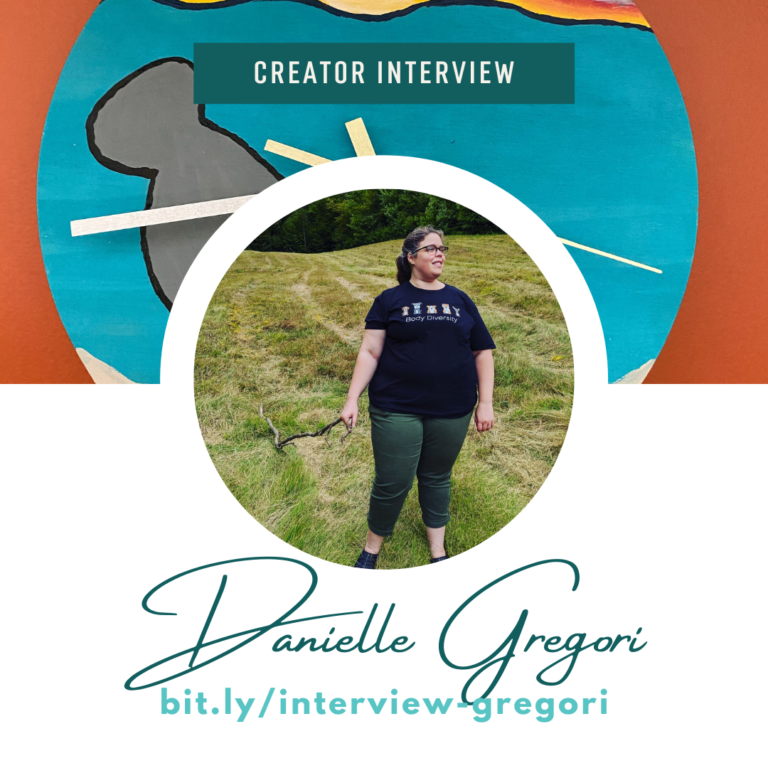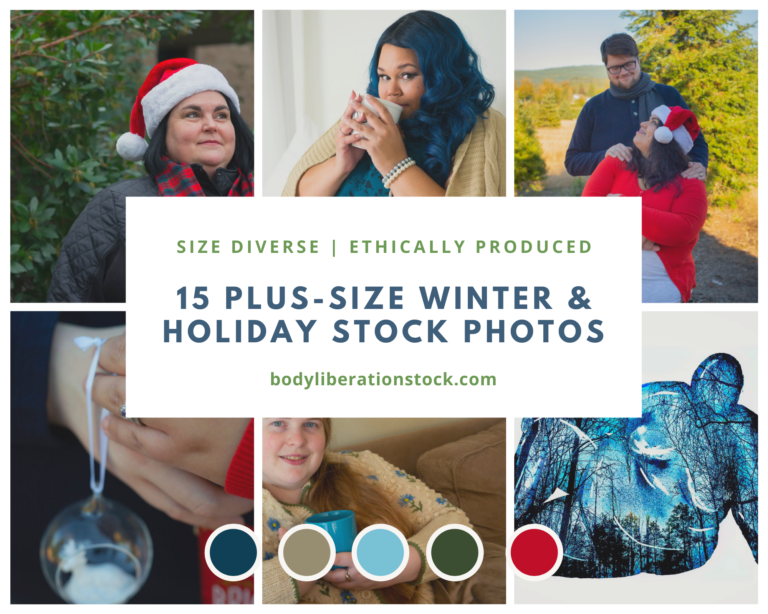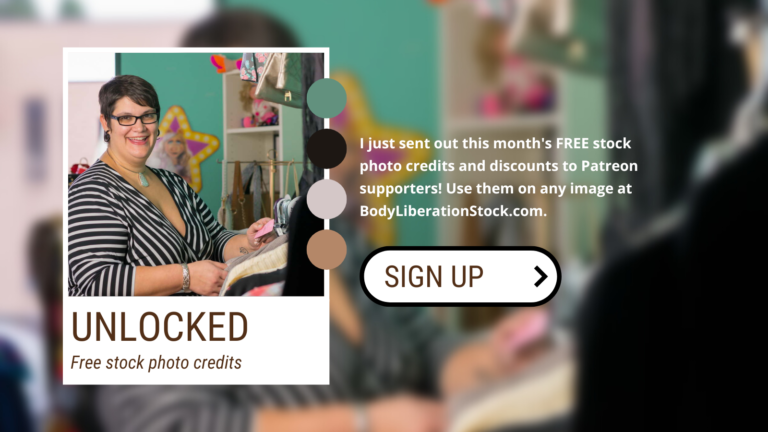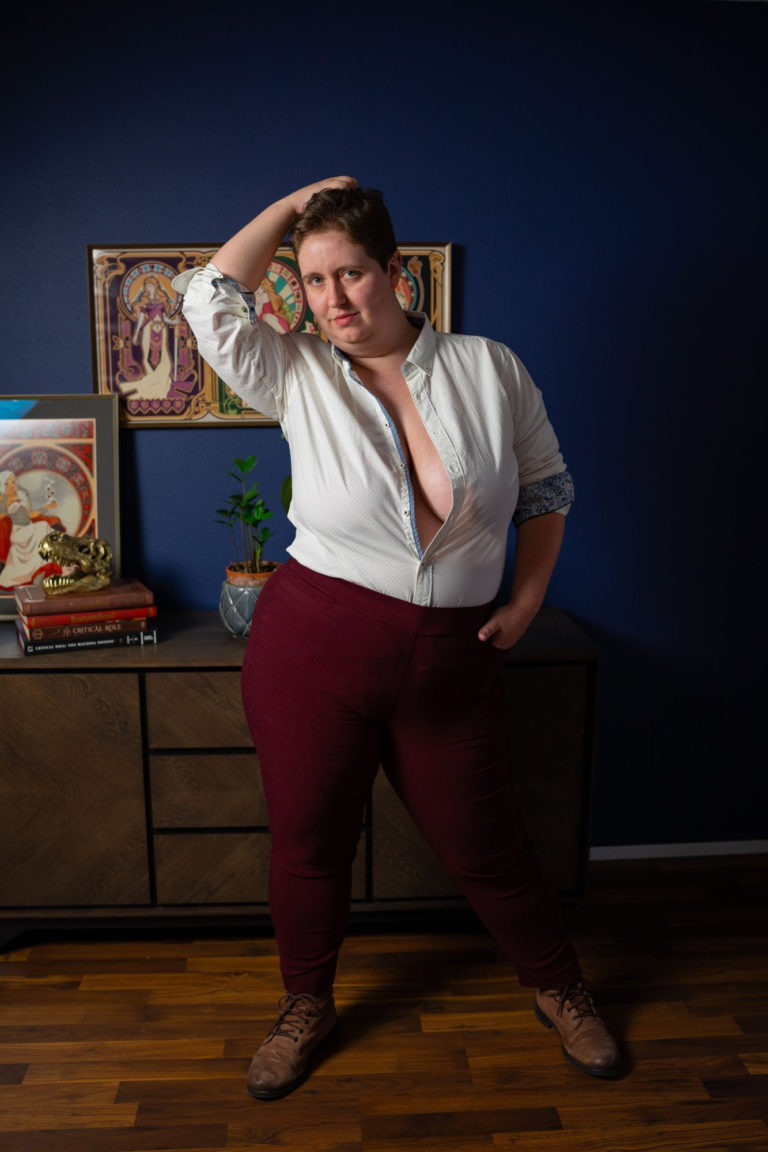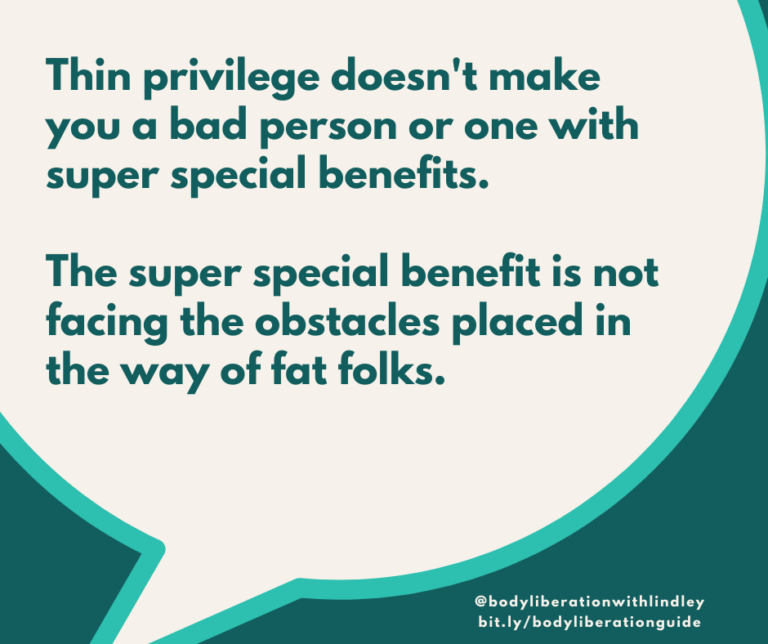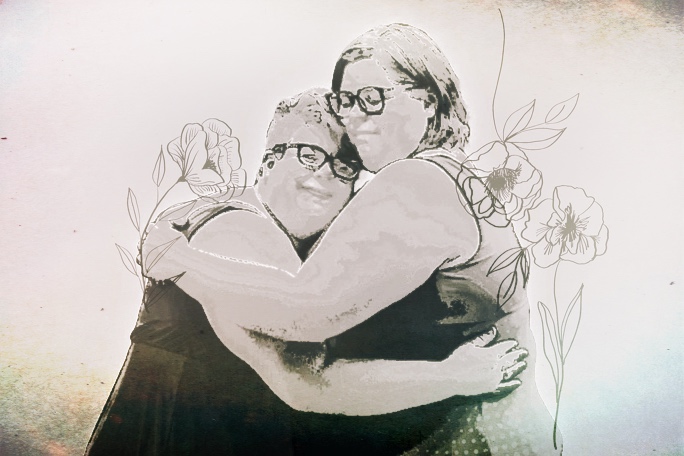LISTEN: Lindley on the Fashion for All podcast with Mallorie Dunn
Image description: A teal square with a chat bubble and the words, “Fat bodies are just treated as this horrifying mystery in the photography community. And I got mad! Fat people deserve to have somewhere they can come and feel safe and accepted and attractive and worthy.” Lindley’s logo is at the bottom.
“Fat people can’t be photographers.” Is that true? I’ve spent the last five years finding out, and on this episode of Fashion for All – The Smart Glamour Podcast with Mallorie Dunn I’m talking about what it’s like to break barriers in an image-focused profession.
We talk about:
- How doing #OOTD (outfit of the day) photos forced me to start seeing my own body
- Why the people photos you see in ads and on websites always look like models
- Victoria’s Secret’s bankruptcy
- My first camera (insert floppy disk here)
- Whether being fatphobic makes you a bad person
Mallorie is the genius behind SmartGlamour, the fully inclusive clothing line. It’s affordable, customizable and ethically produced, and every single item is available from XXS to 15X. SmartGlamour sets the standard for inclusive fashion and I can’t recommend it enough.
Listen or read the full transcript of our episode below.
Transcript
Intro: Hi everyone. Today’s guest on Fashion for All – The Smart Glamour Podcast is Lindley Ashline. Lindley falls under the media category of types of guests we’ll be chatting on in the podcast.
I want her to introduce herself properly. We touched on how she got into Body Liberation work, her work in stock photography, fat phobia in the fashion and photography industries, unlearning harmful thought patterns, activism and more.
Enjoy our conversation!
Mallorie Dunn: Hi there!
Lindley Ashline: Hi Mallorie.
Mallorie Dunn: Thank you so much for joining me.
Lindley Ashline: Yeah, it’s a pleasure to be here.
Mallorie Dunn: Could you please introduce yourself?
Lindley Ashline: Yeah, I’m Lindley Ashline. That’s L-I-N-D-L-E-Y. But I don’t pronounce the D because I’m southern. It’s true, people will ask and I’m like, “I don’t care.” long as it’s some approximation of Lindley, I’m happy.
I run Body Liberation Photos at BodyLiberationPhotos.com. I’m a professional photographer, writer and activist. And I do a lot of work in body acceptance.
I primarily work with people in larger bodies from both a photography standpoint and a writing standpoint. And my whole business is focused on body acceptance, body liberation and fat acceptance. So it’s all about “this body that I am in right now is fundamentally worthy.” And that just comes out in all these different ways.
So, I’ve got stock photography that I do. That’s the photography that you see in commercial uses, like what you see on a company’s Instagram feed or a company’s website or blog. Those are often stock photos that they bought. So I produce stock photos of larger bodies. I do client photography work. That’s where I work with an individual or a couple or a group of people to photograph them specifically. I have a shop that I run on my website. And I do writing for writing clients. And I blog. And all of these things are tied back to this framework of body acceptance.
Mallorie Dunn: Wonderful! And so, I personally know all that since I know you. I actually don’t really know too much how you specifically got into all that. So were you doing general photography first and then figured out how to apply this body liberation to it, or was it like, “Oh, maybe I can learn more about photography so that I can do this work?”
Lindley Ashline: It was kind of both. I’ve been doing nature photography since about 2002 I think. My first camera was borrowed from my college library. This was the very early days of digital photography. And so, the first camera that I really used for sort of hobby-level photography took an actual floppy disc. You put an actual floppy disc in it and carry it around. The thing weighted like a thousand pounds. And it was big enough for a 3 ½” floppy. So I was carrying around a stack of floppy discs. And that was amazing for the first digital stuff.
But I was absolutely fascinated by digital photography. I grew up around people that did film photography, and that didn’t really catch me as much. But digital was cool and sexy and new.
So, I started doing nature photography that way. And I had been carrying it sort of ever since as a hobby, a much loved hobby. But I never thought about doing it professionally because fat people can’t be photographers.
And when I use the word fat, I want to be clear that I’m using it as a neutral descriptor of my own body and of the bodies of people who have reclaimed that word for themselves. I’m not using that as a negative quality.
But I just knew, I have absorbed from culture that fat people can’t be photographers. Who would want to work with a fat lady as their wedding photographer? So I never even considered it. It was always just this much-loved hobby.
And simultaneously, back in the days of LiveJournal—if anybody remembers that…
Mallorie Dunn: Oh, I certainly do. I was a big LiveJournal user.
Lindley Ashline: Oh yeah… for about a decade, I was very, very dedicated to LiveJournal. And there were communities that were like modern Facebook groups I guess. And one of these that I just stumbled across—I guess somebody sent it to me—was based on plus-size fashion… and it was called Fatshionista. And it was all these amazing fat women being stylish and trendy and confident and living their lives and just being fabulous. And it blew my mind! It blew my mind.
I have very much grown up in this paradigm of if you are in a bigger body, there are lots and lots and lots of things you can’t wear or shouldn’t wear. And there aren’t very many things available in your size.
And what is there—if it’s bright colors, you’re not supposed to pick it anyway. So even out of what’s available, you’re always supposed to pick the most flattering things, the things that make you look the thinnest. So it just blew my mind! These women were wearing hot pink or wearing stripes.
For quite a while, I just sort of lurked and just sort of absorbed this amazing, new framework of thought. And eventually, I started doing my own outfit-of-the-day photos because that was very much in style that time, to do outfits-of-the-day or OOTDs. And so I started doing those.
New in the Body Love Shop
And I was just sort of experimenting with the fashion. But what it actually started teaching me to do was to see my own body. Particularly, if you are in a body that is not mainstream approved—and everybody has body insecurities. Everybody with a human body does. But some bodies are more socially accepted than others. And particularly, the further away you are from that standard, the less likely you are to want to look at your body regularly.
You might glimpse at it in the mirror, or you might be in the background of somebody’s wedding photos, whatever, or you might be behind the camera because you don’t want to see yourself… we don’t look at ourselves regularly.
And so, I was forced to start looking regularly at my own body and normalizing that. And from there, from the Fatshionista community, I got linked over to Kate Harding who is a writer who at the time was doing really wonderful fat acceptance and very early body positivity writing. And from there, I discovered the science of bodies and the science of why we know that human bodies don’t really become slower permanently or in the long-term because that’s not how human bodies work—which I think is a little bit off-topic here. But we know scientifically that diets don’t work. And I tend to be very much an evidence-based person. If you tell me something cool, I want to see why. I want to know why.
And I have lived all my life seeing most of the bodies around me attempting to be smaller, the people in those bodies attempting to be smaller and failing. And now I knew why. Once again, it totally blew my mind. It changed my life.
And I started sort of lurking in those communities too, in fat acceptance communities. But I didn’t really do anything about it until about 2015. I was in a crappy dead-end job, a corporate job. And I had this photography skill. And I had this belief framework about the value of all bodies. And I kind of started dinking around on the internet looking at photography courses and professional photographers and see what their work was like. And there were just no larger bodies being photographed and shown on the internet—unless it’s for a specific thing, like maybe a very small plus-size model or some kind of diversity photoshoot where it was clearly like kind of token-is like, “Oh, look how diverse we are… we have one slightly larger model” who’s probably white.
So, as I started thinking about photography as a business, it was really obvious who my target market was going to be because a) nobody was serving these folks, people like me in these big bodies (so clearly, there was a market need for that) and b) I just got really mad about it like, “We deserve this too! We deserve this. Why is nobody serving larger bodies? Why, in the photography community, larger bodies are like hush-hush.
It’s sort of acknowledged that you’ll have clients who are fat—like maybe the mother of the bride. That’s a classic one. And so you have these photography courses online that are otherwise wonderful. But then, there will be like a whole lesson on how to photograph the mother of the bride as if it’s Frankenstein’s bride.
Mallorie Dunn: Right!
Lindley Ashline: Fat bodies are just treated as this horrifying mystery in the photography community. And I got mad! Fat people deserve to have somewhere they can come and feel safe and accepted and attractive and worthy. And here we are five years later!
Mallorie Dunn: Wonderful! And I know that you do lots of different types of photography work, but specifically when it comes to your business and what to do with those photos, you do a lot of stock photography.
And I know, personally just me, from my own personal experience, I feel like sometimes it’s not really understood just how many companies use stock photography. Pre-Smart Glamour, pre- all this part of my life, I did modeling. And one of the ways that I built up my portfolio was doing trade with different photographers so that I could get photoshoots for free, and then they get to use photos for their purposes, et cetera.
And one of the photographers that I did a trade with, he was also a stock photographer. So we traded in the fact that we did some beauty, more glam-shots for my purposes. And then, we did some stock photos for him to use.
And I totally knew that he was going to use them as stock photography and that he was going to sell them. And that was part of the agreement. And then, I got my personal photos back, and then I never thought about it again.
And then, like a solid year or so later, I get this message from this person who’s a facebook friend, but we don’t talk every day, and they’re like, “Hey, I’m pretty sure I just saw a cardboard cutout of you.” And I was like, “Erm, what? Where?!” And he’s like at H&R Block. And I was like, “What?! No, that could not be me. I didn’t do a photoshoot for H&R Block. What’s happening?”
And so, luckily, it was the one in Times Square. So I was like, “Okay! Well, next time, I’m in that area, I’m going to go look.”
So, I walk up to that H&R Block that’s right on 4th and 5th and 7th avenue for folks who live in New York City, and there is a bunch of cardboard cutouts of me, like 15 of them, standing together, leaned up against the window distributed on other H&R Blocks. And I recognized the outfit. And I was like, “Oh, my God! That’s from that photoshoot that I did that I completely forgot about that I knew was going to be used for stock photos. But I didn’t know that a company like H&R Block is buying stock photos from a random photographer in Queens for however much an image, and then blowing them up to be cardboard cutouts.”
There were cardboard cutouts of me around these H&R Blocks. There was one literally on the corner of my best friend’s block. So she would walk out of her house and see a cardboard cutout of me. My mom went and haunted down a cardboard cutout, so that she could get one. She had to go through corporate to get one. So my mom has one that’s in her house.
So, I think people—I certainly didn’t even being somebody who is aware of stock photography, had my photo taken for stock photography—just how businesses use it.
Lindley Ashline: Yeah, yeah. Say you work for a mid-sized company in their marketing department. It’s not Microsoft, but it’s not Smart Glamour. It’s somewhere between—or really, in a company up to very large and powerful companies. You work in the marketing department. And you’re writing a blog post for, I don’t know, Top 10 Tips for something food-related for your company. And you need a photo of food. You’re not going to have the budget to go out and hire a photographer to take photos of biscuits. Let’s say you work for, I don’t know, Carl’s Jr. And you’re writing a blog post about biscuits. You’re not going to hire a photographer. Actually, that’s a terrible example because Carl’s Jr. would have their own…
Mallorie Dunn: Food stylist, yeah.
New at Body Liberation Stock
Lindley Ashline: Okay, never mind. You’re working for a non-food related company and you need photos of food. You’re going to go out and buy or find a free stock photo somewhere. You’re going to acquire a photo of biscuits somewhere on the internet. You’re not going to hire a photographer for that.
So, stock photography is very—I’m going to use the word ‘pervasive’ or ‘ubiquitous’ just because it’s everywhere. That doesn’t mean it’s a bad thing. It just means it’s one of those things that is so common that you don’t even notice it.
Like you said, brochure, stand-ups, cardboard cutouts, billboards on the sides of buses. Every bank ad you see where it’s like here’s this hometown guy standing on this street with a nice quote about our bank, that’s probably a stock photo.
So they’re just everywhere! And there are very large stock photography sites online that sell these photos. Getty is sort of the grand-daddy of them all. iStockphoto—which is owned by Getty—is another big one. You start looking, and there are hundreds of stock photo sites. And it ranges from the behemoth like Getty down to Mallorie’s photographer with the stand-up.
But you just don’t see large bodies in these photos because—and Mallorie, you’re giving a perfect example here. When photographers shoots stock photos, they hire models. And models are predominantly very thin and often white and a certain body shape. They look like models. And so what ends up happening is you end up with these stock photos where you have—
If you’ve ever seen that stock photo of a young female doctor in scrubs who looks probably of Asian descent, and she’s standing in this hallway of a hospital, and she looks like a model, she looks like she’s about 22, she looks like a model, and she’s standing in this impossibly clean hallway—and there’s usually like glass windows down one side of the building—these are very classic stock photos.
Or the classic corporate diversity stock photo where it’s three white men, a black man and an Asian woman, all standing behind a conference table in front of the big window… you know! You know, you’ve seen it. And once you’ve seen these tropes, you can’t ever un-see them.
So, you have these photos that are just everywhere! And they’re one of the big underpinnings of pop culture. And there are just no fat bodies… none! None. Unless they’re very shame-y, what we call “headless” fatty photos, or the B-roll that you see on the evening news when there’s some sort of terrifying story about obesity. It’s usually like people with their heads cut off and their legs cut off, so it’s just belly and torso. You can find those. But you just don’t have positive depictions anywhere of fat bodies in stock photography.
So, as far as I know, I was the first, and I’m still one of just a couple of people even doing this work. And it just blows my mind that two-thirds of the American population just is not represented.
Mallorie Dunn: Right, right.
Lindley Ashline: Like if nothing else, what a market opportunity, you know?
Mallorie Dunn: You know, that’s how I feel about fashion too. If nothing else, don’t you want to make money by making clothes for the majority of people? No…?
Lindley Ashline: Right! Yeah… it’s really interesting to observe how culture affects capitalism I guess because it is very clear that these market opportunities exist, but the stigma of serving that market, or even of depicting the people in that market, the stigma is so strong that people aren’t willing to touch it.
When Victoria’s Secret declared bankruptcy, I knew a lot of other fat folks who are like, “Okay! You never wanted to take my money… so bye!”
Mallorie Dunn: Right! Right… I mean, I did a video with Crystal Bugan. She was interviewing me. So she asked me lots of questions. And one of the questions was a common question I get. Why don’t more brands make clothes for bigger bodies and all bodies? And it’s a very long answer, so I won’t get into the whole thing. But at the end of it, I summed it up by saying, “If the people in charge are fat-phobic, then even if they attempt to do it, they’re not really going to do it right.”
If you’re a fat-phobic person, you don’t truly care about fat people, plus-sized people. You don’t see them as a valued customer or a valued human being, somebody with worth, somebody that you want to do market research into that you want to use as a model and uplift in that way, quote and quote, if that’s how you think about models which is how society thinks about models.
So you’re going to just dip your toe in enough to maybe get some money off of it. But you’re first of all not even getting the full amount of money you can get from it if you were doing it properly. And you’re also just not going to do it properly because you don’t see those people as worthwhile.
And I want to bring back a point that you mentioned earlier where you said and that you brought up that what you usually see when you see stock photography, and therefore models in stock photography is the mainstream approved version of people, right? And in general in imagery, when we’re seeing mainstream “approved” people, that’s basically like representative of 5% of the population because it’s people who are thin and usually white or light-skinned at least, who are usually tall, are usually able-bodied. That combination of human being is a very small proponent of the population. But because it’s what everybody sees, it’s like we’re all just subconsciously tricked into thinking that, “Oh! Well, that is what the majority is.”
New at Body Liberation Stock
And so that’s why it’s so detrimental at a certain level because we’re just going around taking an imagery and then making our own conclusions and feelings based on what we see. And so that’s why representation is so important.
And another thing that you mentioned was, in general, does not seeing fat people as photographers—which I’ve worked with so many photographers back when I was a model, and none of them were plus-sized or fat.
Then at the same time, I see a lot of models even now today talking about “Oh, I might shoot with this photographer,” but then you look at their portfolio, they don’t ever share photos of any plus-sized models that they take. They only share photos of the street-sized models. And that’s kind of like one of the little checks on a list. If they’re going to actually work with a photographer, it’s like, do you actually share the photos of the fat people that you may or may not work with because then why would I want to work with you?
Lindley Ashline: Yeah, I have a fat friend who did something that was, for her, very vulnerable, very scary. She modeled for a set of fine art nude portraits with a photographer in Oregon—it wasn’t somebody that I was familiar with—who happened to be a thin, white, male photographer. He wanted to start bringing some diversity into his portfolio. So they arranged this photo session. And like I said, it was very scary. It was very fundamentally horrible for her.
But it was also a very powerful experience for her to do that, to model. She wrote this beautiful blog post about her experience to go along with the photos. And that photographer did post her photos on his blog along with the beautiful things she had written about how vulnerable and freeing it was to do that. But those photos never made it in his portfolio. And not long after that, the blog post just quietly disappeared. I mean, how must that feel?
So, it’s just knowing that there is this fundamental difference between what were you being shown, not just in the media as a whole, but in these stock photos that are totally ubiquitous that we don’t even notice, and the fundamental difference between what is shown there and what’s all around us in real life, not only does it show us what kind of bodies are acceptable or normal, it also tells us who’s welcome.
Mallorie Dunn: Right, right!
Lindley Ashline: After watching my friend go to this experience, I ended up writing a whole ebook. It’s free, it’s at my site, BodyLiberationPhotos.com, you can download it. But I have a whole ebook that I wrote on how to find a photographer who’s going to respect your body and who’s not going to be ashamed of the photos of you that they take and who is going to treat you well and treat you equally, and what to look for in their portfolio, and what to look for on their site, and what kind of questions to ask.
And now, as we record this in 2020, there are an increasing number of body positive photographers. But not everybody can afford to travel to Seattle to work with me. Not everybody has somebody who advertises themselves as a body positive photographer who is in their locality. So I ended up writing this whole thing on “here’s how you find out.”
But the biggest thing is what’s in their portfolio, what are they proud of. That’s just the biggest thing right there.
And I have had my own photos taken. I’m not a fine-art self-portrait artist, so I have my own photos taken. And the first thing I looked for was are there any larger bodies in their portfolio. Who did they want to work with?
Or if I’m looking at a clothing store’s website, or when I look for a therapist, if there are no bodies like mine on their social media feeds or on the materials on their website, from my own safety, I have to assume that I’m not welcome. And that might not be a conscious decision at I’m making. But it very much tells me who’s welcome.
And so, when we talk about stock photos from the business side, as I’m talking to business owners about why they should be buying diverse stock photos instead of just photos that involve thin, white models, it’s a matter of who do you want to feel welcome, who’s your target market, and are they represented.
And it’s such a basic thing, but there’s still so much stigma around big bodies that business owners do not tend to think of it either.
Mallorie Dunn: Mm-hmmm… well, I mean I think that’s just because, as I brought up before, this society as a whole is fat-phobic. And so much of it is insidious. Don’t get me wrong, there are these people that are terrible trolls on the internet. But the average person, there’s a lot of people who hold a lot of fat phobia inside themselves and don’t really know it. They’re not out on the street yelling things at people in bigger bodies.
Lindley Ashline: Yeah! Yeah. They’re not throwing milkshakes…
Mallorie Dunn: Right, right.
Lindley Ashline: And it’s not our fault that we have been taught these things. I mean it’s our fault if we’ve realized that we have been indoctrinated with these things and we don’t work to do better. But it doesn’t make you a bad person to have grown up with these beliefs… because we all did. But once you know, then you can start learning to get rid of those beliefs.
But yeah, we all grew up with these things. I mean, I certainly grew up with all kinds of messages that were embedded in my brain that I’ve had to slowly pick apart over the years. And so there’s nothing wrong with sort of facing up to that.
And business owners are just as prone to that as anybody else. It doesn’t mean that any particular business owner is malicious or doesn’t want fat people in their businesses necessarily.
And also, the thing of it is too, if you need a stock photo for a particular purpose, and there aren’t any available that are diverse, you’re going to buy the one with the thin, white person, and you’re going to go about your day.
Mallorie Dunn: Right! Right, right.
Lindley Ashline: I get emails all the time from people who are like, “Oh, my gosh! I found you on Google, and I had no idea you existed. And now I’m replacing half the photos on my website because I have options now.”
Mallorie Dunn: …which is great, which is great. And do you find that most people find your stock photography from Google? Do you feel like you work hard on your SEO to make that possible?
Lindley Ashline: Not historically simply because as Mallorie knows having watched my Facebook feed, the technical side of running a stock photography website is very challenging. And I’m not a coder. I’m not a developer. And so I’m just kind of kludging together what I can over time.
And the platform that my site has been on is really notoriously bad for SEO. So I’m hoping to launch in November 2020—so not long from now—on a new platform that should be much better for SEO.
So, so far, most of the people who found me have found me through the body positive community. They’ve ran across me on Instagram or through the Health at Every Size community.
Mallorie Dunn: Yeah… I mean, honestly, all of those things kind of also help your SEO. If you’re ever included in some kind of like listacle or a blog post or something else, all those click backs do help in general with your SEO.
But I do want to make a quick point when you were talking about how it doesn’t mean you’re a bad person if you hold these biases. You just have to realize that you have them, and then work to undo them.
I mean, that’s something that I feel like is such a general issue with the world, that people are so defensive. People will do almost anything to not be wrong. So if they feel like they’ve been doing something that is “wrong,” you really have to be a person who is willing to—even your own self, admit you’re wrong. It’s not like you need to come out to the world and be like, “Oh, my God! I held this belief in a terrible… let me tell everyone about it.” Just to yourself, be like, “You know what? This was something that I used to think. And I’m now realizing that it’s not great. And I’m going to work to undo that.”
New at Body Liberation Stock
Lindley Ashline: Yeah! And it’s hard. And in addition to not being software developer, I’m not a psychologist. But my understanding is that we are very defensive about that particularly because our brain wants to protect the beliefs it already holds. It’s like learning that you’ve been standing on somebody’s foot for 20 years, and you didn’t mean to step on their foot. And maybe all long, they were kind of poking you on the shoulder and going, “Hey, you’re stepping on my foot,” but because you really firmly believe that you weren’t stepping on anybody’s foot, it’s like suddenly realizing that you were hurting people—even if you didn’t mean to.
So it’s not only this process of going, “Oh gosh! I have had this belief that is incorrect or that’s bigoted,” or whatever, “damaging,” but then also facing up to the fact that maybe you’ve been hurting people all this time even if you didn’t mean to and even if you didn’t realize it, that’s horror! And our brain wants to sort of protect us from that because, gosh, what a realization to have to face up to.
So, people do get defensive. It’s part of that process.
And I do a lot of work on my Instagram, education for people who have come to these realizations about fat bodies and who are ready to move forward like, “Okay! Now, what do I do about that?”
I don’t do a lot of one-on-one where I’m leading people up to that point. There are other wonderful people who do that like Jess Baker, lots of people on sort of the body positive side who do more of that. Where I tend to pick up is people who are like, “Okay, I’m ready to root out these beliefs. I’m ready to start working to end weight stigma in my own head and also what I can do in the world.” So that’s where I tend to pick up.
Mallorie Dunn: And that’s actually a great segue way because I was going to start asking you about—obviously, you do the photography, but you also do so much other work specifically on the internet, specifically in this community. You mentioned that you made that one ebook that is kind of the bridge between the world. But I know that you do much more than that.
So can you talk a little bit about that side of your—I don’t know if you want to call it “that side of your business” or “that side of who you are as a person and what you’re trying to do in the world…”
Lindley Ashline: Yeah, I have my fingers in a lot of pies. But I’ll be honest, a lot of my activism… I have some activism that I don’t tend to talk about quite as much because a lot of it is sort of privately done. But I spend quite a bit of time in healthcare provider groups where I’m a guest essentially because I’m also not a healthcare provider.
Today, we’re going to talk about all the things that I’m not. But because I have a lot of friends and acquaintances and professional colleagues who are in the Health at Every Size community which is a medical model for treating people in all sorts of bodies equally in a weight-neutral way, because i have a lot of friends in that community, they tend to invite me into these provider spaces. And so I have this really valuable, almost unique, opportunity to advocate for fat patients in those communities. And these are people, in general, who are already invested in getting rid of their weight stigma and in treating all kinds of patients equally. But sometimes, they don’t necessarily…
Like rooting that out of yourself is hard, especially when you have an entire freaking medical degree, you’ve had all these education, that was based in weight-centric paradigms. So rooting that out is hard. And sometimes, those people need education too or need somebody in there who’s like, “Okay, let me tell you how that’s going to come across to your fat patient.”
So I consider that a really important part of what I do even if you’re not really seeing it publicly. But beyond that, I do a lot of stuff that’s kind of a crossover, a little bit of—like every week, I put out some kind of body positive journal prompt on Instagram and Facebook. So I do that. I work to normalize fat bodies just by posting a lot of focus of my work. The more that you see bodies that are like yours, or unlike yours, the more those bodies become normalized. So it’s kind of this mish-mash of more on the body positive end of “here are some journal prompts” that are kind of squishy feel-good, and then a lot of things that are sort of anger-driven because the more time I spend thinking about privilege and culture, the more I get mad, I’ll be honest, about the way that fat people are treated and the beliefs that we hold about fat people.
And so, I also talk about thin privilege. And I talk about weight stigma. And I talk about some topics that are pretty uncomfortable. So I feel like, like I said, I have my fingers in a lot of pies, but they all sort of tie back to the one. I’ve realized that I have these beliefs, now what?
Mallorie Dunn: Right, right! I think that being able to put the content out also in so many different ways… not everybody learns in the same way, not everybody takes action in the same way. So it’s good to have that variety of stuff.
And then, I know you also started a side business that was at first a box and is now no longer a box.
Lindley Ashline: Yeah! So for a year and a half, from January 2019 to June 2020, I ran what was called The Body Love Box. And that was a monthly subscription box that was based on fat positivity. And there was usually some kind of zine in there. If you’re not familiar with zines, they’re pen and paper items that sometimes people will hand-produce them, and sometimes people will print them out on a copier, and some of the ones I bought were actually from a small press where they were sort of professionally produced. But they’re usually half the size of an 8.5” x 11” sheet, like 8.5 x 11” folded over with a cardstock cover. And they are sort of indie underground—a lot of them had very raw, honest personal stories in them. So usually, there’ll be one of those.
There would often be a fine art print either of my own work or from a fat positive illustrator or another photographer; and then, sort of a mix of useful stuff and fun stuff. And when I say “useful” stuff, it might be something that’s useful for your body image; and then the fun stuff. We had sugar scrubs. We had soaps. And we had some self-care items. One time, we did cool coloring pages—a couple of times actually. And it was really cool. And it made a real difference for the people who subscribed.
But what I found is that subscription box models tend to be based either thin air—by which I mean the companies that are running them are taking out loans to do it and they’re really not financially sustainable—or they’re based on exploitation. And that sounds very dire, but what I mean by “exploitation” is a lot of these subscription boxes run by approaching small businesses and getting free samples from them or getting something heavily discounted in exchange for the exposure. And from the beginning, I decided that I didn’t want to do that. So everything in the boxes was fair, living wage for everybody—including me. And I found that I couldn’t make it work. I just could not make the finances work.
And so, what I did instead was I turned that into a web shop. So it’s at the BodyLoveShop.com. You can also get to it through my main website. Everything is based on this central website at BodyLiberationPhotos.com. So you can always find everything there.
But what I did was I decided that, instead, I was going to be the central point for fat positive builds and art work. And if you need a high weight limit, you can find it there.
Mallorie Dunn: Hmmm…
Lindley Ashline: Now, I don’t do a lot of apparel right now… long story, long-story reasons. I’m trying to figure out how to make it short. But a lot of the things that you’ll find through the site are affiliate links to other websites. But I can’t possibly carry inventory of chairs.
Mallorie Dunn: Yeah, that’s what I was going to ask.
Lindley Ashline: …or books! And so, a lot of these are Amazon affiliate links. So my job is to curate. So if you find something on there, say compression socks, I didn’t just google for those, I didn’t just search Amazon for those. Those are the ones that fat people have recommended. So everything on there is something that somebody I know has used and loved.
And then, there’s all kinds of art work. There’s fine art prints for your wall. There’s cool soaps. And again, all these things are either body positive or fat positive or created by a fat or otherwise marginalized person.
And so, the shop is really cool. And that’s another thing that is sort of actively in development.
New in the Body Love Shop
But how the boxes come into this is, when I have time, some of the old boxes are still on the site. They’re really great. Go check it out! But what I’m going to be doing is developing seasonal boxes where there will be limited brands. And you will be able to get back to the site and say, “I want to get a holiday box” or “I want to get a summer box,” and you’ll be able to do that without having to subscribe.
Mallorie Dunn: I mean, personally—this is just totally like from my own personal consumptionism advice on the internet—sometimes, I would much rather do that than subscription. I’m really not a fan of subscription things. I have a subscription for my menstrual products and things that I don’t want to think about. I just want to have them come back to me when I need them. But to me, that’s almost like setting up a recurring payment for something, and it just auto-orders. When it comes to something like that, your box, or even just something that, yes, can be useful, but is mostly like just fun, yeah, I just never sign up for subscription versions of those things. I just can’t do it.
Lindley Ashline: Honestly, I don’t either. I have a sticker subscription that I love and that comes in every month. It’s like $10. But yeah, what I also found too is that the subscription model is really hard for marginalized people who are systemically paid less.
So, the platform that I was using, it gave me people the opportunity to skip a month or to cancel and come back. And so, I would have a lot of people who would do every other month or every third month; or whenever their finances allowed it, they would reactivate it. And that of course was fine too.
But I just finally decided that, if I can’t do this at a living wage for everybody who is contributing things to the box, then it’s better to do it as a limited run.
Mallorie Dunn: Right! Right, right. I agree. And so now that you have just the shop—I mean, obviously, the things that you mentioned, they’re affiliate links and you go to the site to buy them. But the things that you used to carry in the box, do you still have them and ship them out or does it link to the makers’ shops?
Lindley Ashline: Right now, everything that I have left in stock—and some of that, like I said, were boxes that were over-stock at the time, and some of them are individual items—those things are all on the site as in-stock items. And right now, I’m working really hard on the stock photo site to relaunch that. When that is done, I’ll be coming back to the shop and I’m going to be investing in some more actual in-stock items so that you know it’s coming directly from the artist.
Mallorie Dunn: Cool! I’m excited for that!
Lindley Ashline: Yeah, because there’s just thousands—I mean, I’ve got a spreadsheet earlier that’s probably got a thousand people on it. And I haven’t even done any research. These are the artists that I just run into on Instagram or on Facebook or that somebody recommends. There are so many artists out there. And they’re making illustrations and beautiful fine art photos and collages and soaps and perfumes and zines and just everything you can imagine people are out there making. And right now, there isn’t really a central place to find those things that’s truly kind of safe in the sense that the shop is, like I said, everything’s on there, everything is vetted or I know somebody who has. If there’s a book on there, either I’ve read it, or I’ve skimmed it, or I’m familiar with it.
There’s no weight loss talk. There’s no sneaky diet culture. You’re not going to get halfway through a book, and then be bombarded with something negative about fat bodies. And it’s just a really sort of safe place to shop. That’s really my goal.
Mallorie Dunn: Yeah, which is so important!
So towards the end of each podcast, I ask folks what they’d like to see various industries change. So I’m going to ask you specifically about the photography industry and maybe even more specifically stock photography, within that industry, but it’s up to you. What is something you’d like to see change in that space aside from, in general, having more accurate representations of people? Is there something else tied to that, or something else completely different that you feel like really needs to change about that?
Lindley Ashline: Well, I think you’ve pretty much summed it up in the sense that there needs to be better representation. But for my client photography, I want the industry to change so that it becomes expected for a photographer to cater to a variety of bodies. I want it to become unfashionable to not do that, to not be inclusive. I want inclusivity and just respect for every single different type of body to become so important that you can’t survive as a business and not do it.
I want to be crowded out of business because there are so many fat positive photographers. If I went out of business because I had too much competition in this niche, I would be so happy.
Mallorie Dunn: Yeah!
Lindley Ashline: And then, I would probably find another thing that had been a hobby before in the realm of body acceptance and then go pursue that, maybe I’ve read a book… I don’t know. But I want it to become the norm and not the exception.
And the same in stock photography… I want it to be the point where we have the same proportions of images of thin, white bodies that meet a certain beauty standard as we have those bodies in the real world. I want it to become proportionate.
Mallorie Dunn: Yeah, that’s why I always use the term “accurate” representation because I want it to be what actually exists in the world.
Lindley Ashline: Right, right. And actually, to bring this back to plus-sized fashion too, one of the types of client photography that I do is boudoir photography. And if you’re not familiar with that, it’s sort of saucy, sexy. It’s not porn. It’s not soft core. It might involve fine art nudes that are very classy and very artistic. But it’s sort of lingerie shots, and it’s saucy and it’s sexy. And having this for very, very large bodies is really revolutionary because how often do you see that? Never!
And in doing these photographs that are beautiful and respectful and not objectifying is a really cool thing both from a photographer’s standpoint and a client standpoint. But the point of this is that many boudoir photographers offer wardrobe to their clients. And what that means is that, when you come in, there’s a closet or a room or racks of clothing of beautiful, sexy lingerie—like really nice stuff, beautiful, high quality stuff. And you can flip through until you find the things that you really love and that, more or less, you and the photographer might put safety pins in the back so that…
Mallorie Dunn: Right, right, right…
Lindley Ashline: but I want plus-sized fashion to get to the point where I can offer wardrobe! I have a few robes and things that are around that I do offer people when they come in. But I make it clear that I do not and cannot afford wardrobe because the options for plus-sized lingerie, especially above a size 26 (US), are so sad and so limited that I can’t have beautiful racks of things because those beautiful racks of things wouldn’t include all my clients.
But if I had a client who comes in, especially with all the promises I make about it being a positive experience, if I had a client who comes in and can’t find something they could wear, how frustrating would that be for them.
And so I just don’t offer it. And it’s fine because I advise people and help them find things before they come in. But I want plus-sized fashion to progress to the point where I can offer wardrobe and it’s just not a big deal.
Mallorie Dunn: Yeah, that will be ideal. And similarly to what you said about stock photographers, I feel that way about fashion brands. I think, in general, the fashion industry is viewed for good reason as very competitive and cut-throat. No one wants to help each other, blah-blah-blah. But I don’t feel that way. When I consult other small businesses, I encourage them to get as many sizes as I can get them to make and try to slip in when we’re not talking about like, “Oh! Well, you know… this concept that you have where the average person is a medium, it’s actually not correct. There are stats to prove it. So maybe your size chart needs to be different.” There needs to be more options, not less. So I agree.
And to close it out here… do you maybe have some positive words or motivation of any kind to someone who maybe is interested in photography but is in a bigger body, and therefore doesn’t feel like it’s a place for them?
Lindley Ashline: You know, with the popular advent of body positivity as a movement, it’s changing so many things and so many industries… and photography is one of them. As more people, from the standpoint of “I want to own a photography business” or “I want to increase my skills and maybe do that someday, but I’m in a larger body,” there’s so much market opportunity right now because the more people who become aware of the body positive movement and start working on their own body image, the more demand there is for body positive photography.
And the market is totally different from where it was 10 years ago or 20 years ago. There are so many places that don’t have any presence at all of a body positive photographer. But also, the awareness that fat people or even medium-sized people can do whatever they want career-wise is increasing.
New at Body Liberation Stock
I know fat people who do wedding photography. I know fat people who do glamor and do all these family portraits and boudoir. All these areas of photography are opening up. And what you might find is that, if you seek out your local photography club, that might not be as representative, but there’s the whole internet. Come talk to me. I will answer your questions about what that’s like. I will be happy to give you a little bit of mentoring. And if you want, we can do some consulting. I’m great for that. Come ask me those questions.
But really, the world is opening up for fat photographers because there’s so much more recognition that, at people, we belong everywhere.
And ultimately, photography is about the experience the client has. So if you’re focused more on the experience that you’re giving the client than about being self-conscious about your body, then it’s a lot easier to deliver a really wonderful experience to the client that just isn’t about your body.
And honestly, so many people are […] more comfortable with someone who looks like them aiming a camera at them in a way that they might not be if it were someone in a more socially-acceptable body. So remember that your presence is a little bit of a gift to your clients or your models or your friends that you’re working with.
And I’m not saying that that’s “Oh, because you make them feel better about their own body because maybe they’re thinner than you” or whatever. That’s not what I’m saying at all. It’s just that it’s very comforting to have someone who looks like you, or maybe someone who is not whatever you think of when you think of professional photographer—insert mental image here—just a person.
And when I started photographing people, I felt like, kind of to make up for my fat body, I had to be super polished and super professional and very serious… and that’s not me at all. And it was very awkward. But after the first couple of clients, I realized that I could just be myself. And being myself and being relaxed and being both accepting of my own body and accepting of theirs creates this really amazing synthesis that makes them so much more comfortable.
Mallorie Dunn: That’s wonderful! That’s a great inspiring note to end on.
So I know you’ve mentioned it a few times, but let’s mention it again. Where can people find you and your work on the internet?
Lindley Ashline: You can find me and everything that I’m into, all my pies, at BodyLiberationPhotos.com. I’m on Instagram at @BodyLiberationwithLindley. And I’m on Facebook at @BodyLiberationwithLindleyAshline. You can follow me on Twitter at @LindleyAshline, but I’m not very present there. So your best bets are Facebook and Instagram.
I have a really awesome newsletter. I’m just going to say it myself that I send out every Monday called the Body Liberation Guide. And you can also find that at the website under more at the top of the page.
Mallorie Dunn: Wonderful! And I will hyperlink all of that in the shownotes. You can just head there in your platform right now and click right through.
Lindley Ashline: Thank you so much, Lindley!
Mallorie Dunn: Oh, thank you for having me, Mallorie. It’s been great!
Outro: I hope you enjoyed listening to this episode of Fashion for All. Please be sure to check our shownotes for information and links to our guest and their work. Be sure to subscribe or follow us on your podcast platform of choice. And leave us a rating and review on Apple Podcast to help others find the show.
For more Smart Glamour goodness, you can head to SmartGlamour.com and follow us on Facebook at /smartglamour and Instagram at smart_glamour. Thanks!
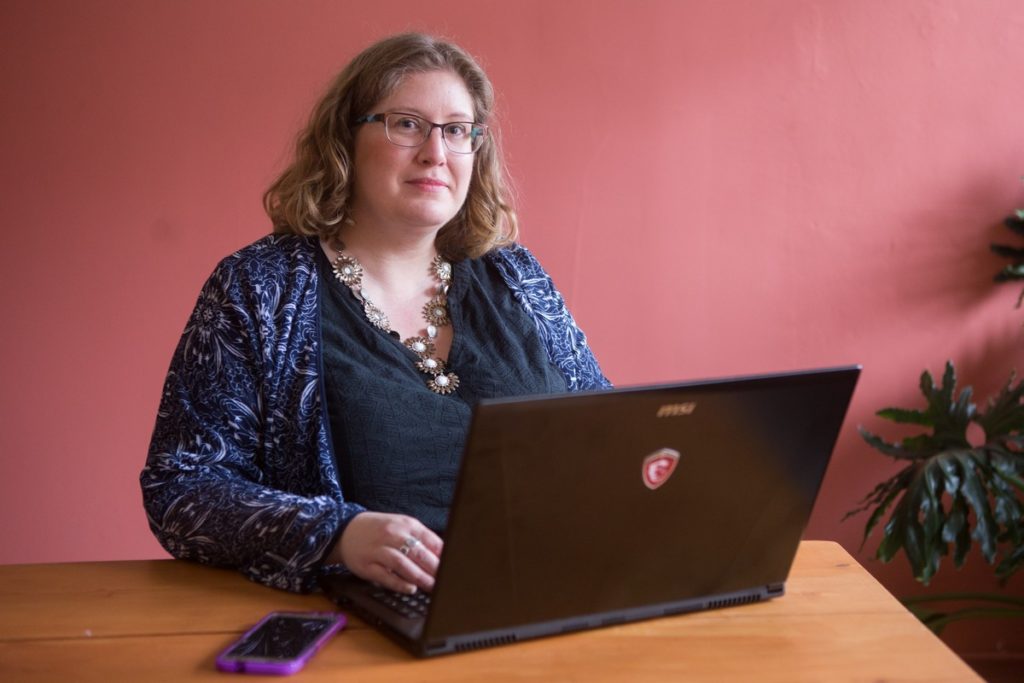
Let’s dig deep. Every Monday, I send out my Body Liberation Guide, a thoughtful email jam-packed with resources for changing the way you see your own body and the bodies you see around you. And it’s free. Let’s change the world together.
Hi there! I'm Lindley. I create artwork that celebrates the unique beauty of bodies that fall outside conventional "beauty" standards at Body Liberation Photography. I'm also the creator of Body Liberation Stock and the Body Love Shop, a curated central resource for body-friendly artwork and products. Find all my work here at bodyliberationphotos.com.

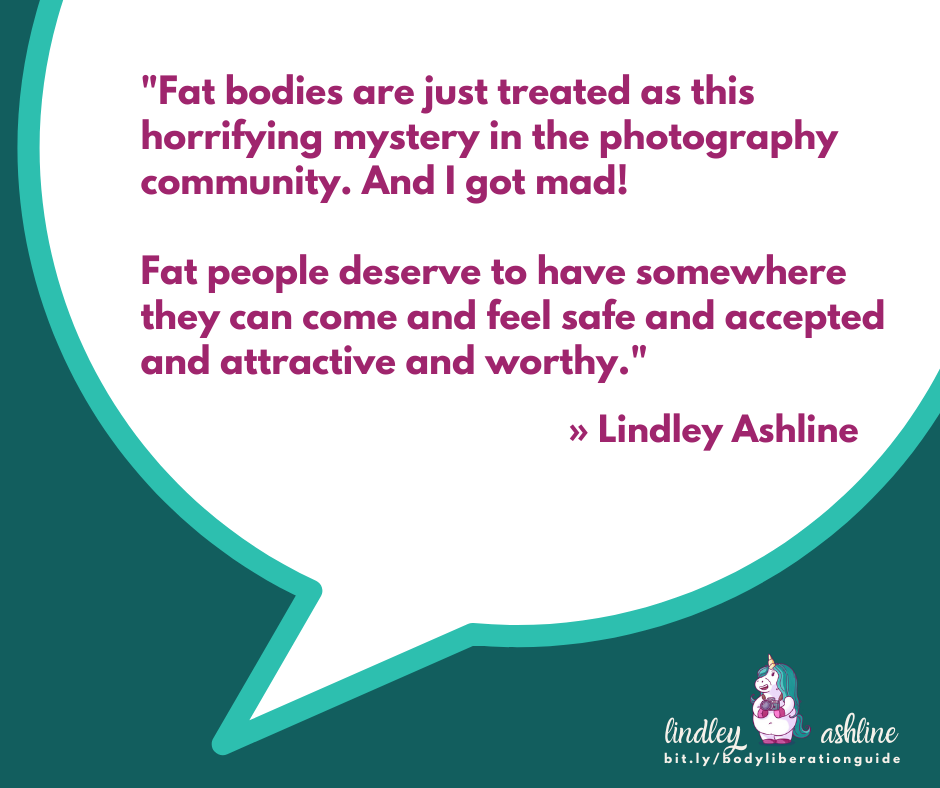
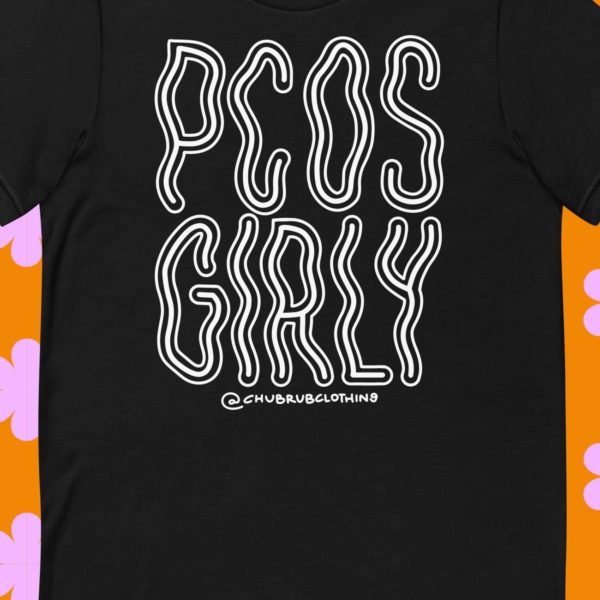
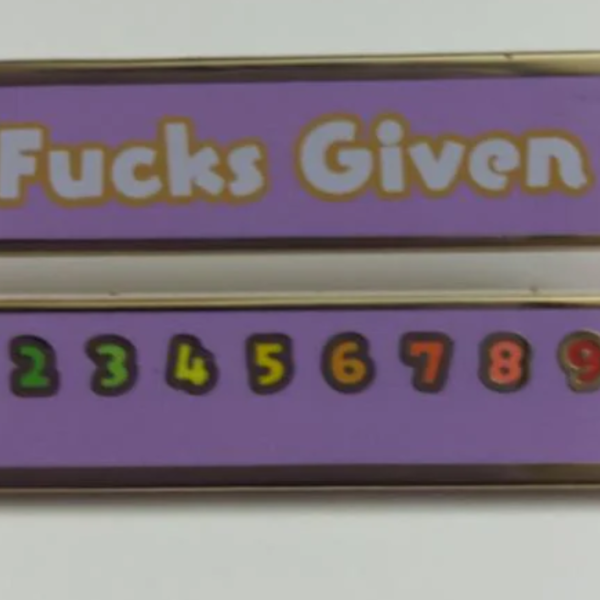
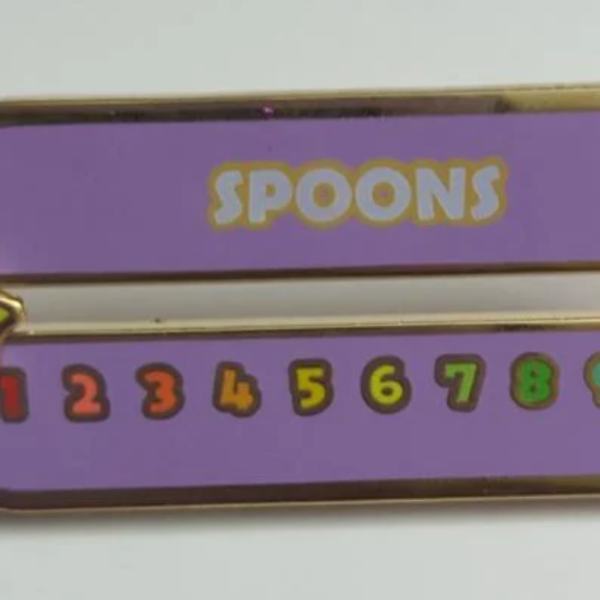
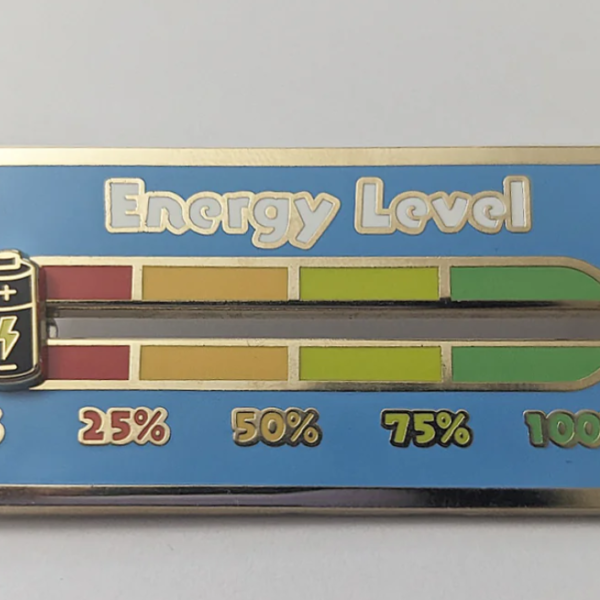
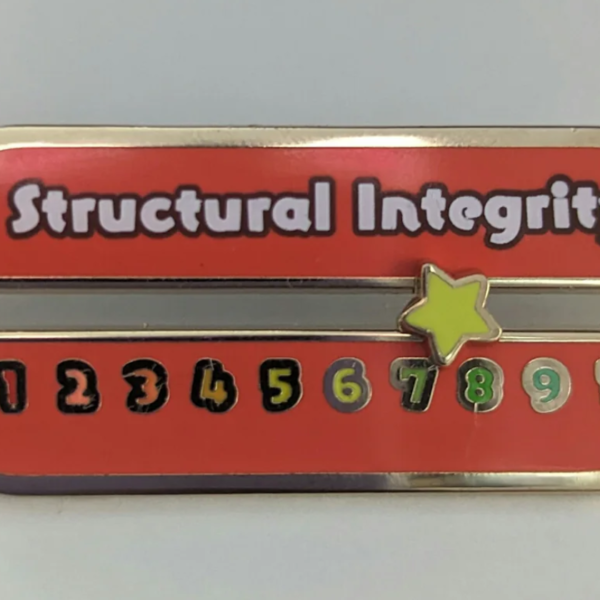
![Illustrated Art Stock: Plus Size Woman Covered with Flowers [Body Liberation Stock exclusive] - Body Liberation Photos & Stock](https://bodyliberationphotos.com/wp-content/uploads/2024/09/Illustrated-Art-Stock-Plus-Size-Woman-Covered-with-Flowers-Body-Liberation-Stock-exclusive-94337-600x600.jpg)
![Illustrated Art Stock: Plus Size Woman Twirls in a Skirt [Body Liberation Stock exclusive] - Body Liberation Photos & Stock](https://bodyliberationphotos.com/wp-content/uploads/2024/09/Illustrated-Art-Stock-Plus-Size-Woman-Twirls-in-a-Skirt-Body-Liberation-Stock-exclusive-94328-600x600.jpg)
![Illustrated Art Stock: Plus Size Woman Twirls in a Skirt [Body Liberation Stock exclusive] - Body Liberation Photos & Stock](https://bodyliberationphotos.com/wp-content/uploads/2024/09/Illustrated-Art-Stock-Plus-Size-Woman-Twirls-in-a-Skirt-Body-Liberation-Stock-exclusive-94323-600x600.jpg)
![Illustrated Art Stock: Plus Size Woman with Hands Over Breasts [Body Liberation Stock exclusive] - Body Liberation Photos & Stock](https://bodyliberationphotos.com/wp-content/uploads/2024/09/Illustrated-Art-Stock-Plus-Size-Woman-with-Hands-Over-Breasts-Body-Liberation-Stock-exclusive-94318-600x600.jpg)
![Illustrated Art Stock: Plus Size Woman with Hands Over Breasts [Body Liberation Stock exclusive] - Body Liberation Photos & Stock](https://bodyliberationphotos.com/wp-content/uploads/2024/09/Illustrated-Art-Stock-Plus-Size-Woman-with-Hands-Over-Breasts-Body-Liberation-Stock-exclusive-94313-600x600.jpg)

